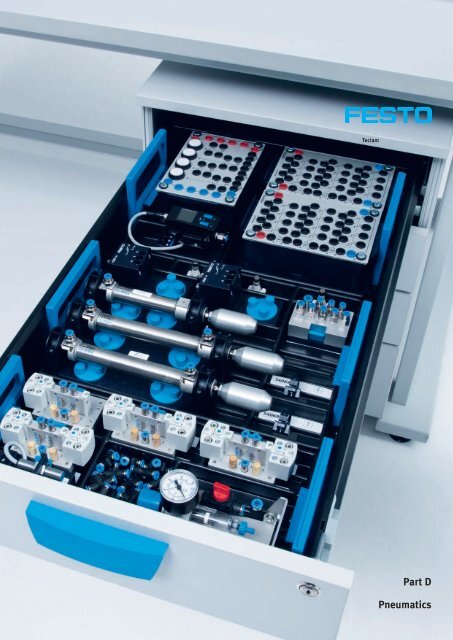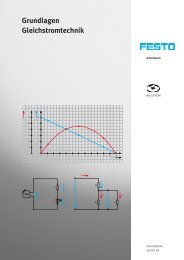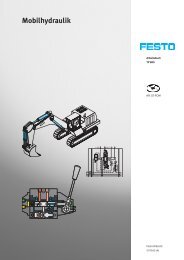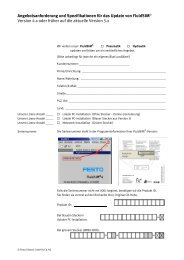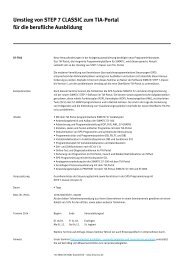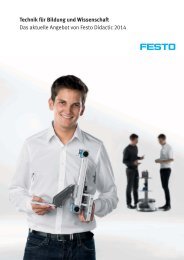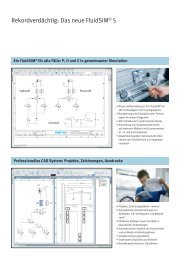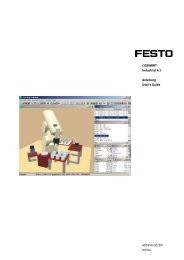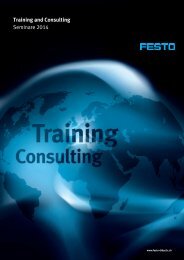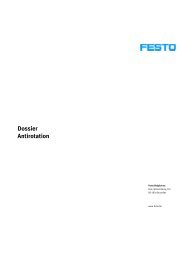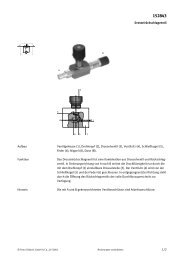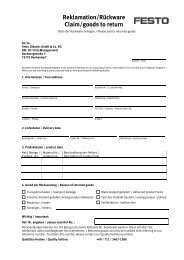Teciam Pneumatics, Basic Technologies - Festo Didactic
Teciam Pneumatics, Basic Technologies - Festo Didactic
Teciam Pneumatics, Basic Technologies - Festo Didactic
Create successful ePaper yourself
Turn your PDF publications into a flip-book with our unique Google optimized e-Paper software.
<strong>Teciam</strong><br />
Part D<br />
<strong>Pneumatics</strong>
<strong>Teciam</strong> > <strong>Basic</strong> <strong>Technologies</strong> > <strong>Pneumatics</strong><br />
© <strong>Festo</strong> <strong>Didactic</strong> GmbH & Co. KG • <strong>Teciam</strong> 3.0<br />
Contents<br />
Table of Contents Introduction Introduction................................................................................. D-3<br />
Training Approach Training Approach........................................................................ D-3<br />
Technology Contents Technology Contents.................................................................... D-4<br />
Training Aims Training Aims and Core Competencies.......................................... D-5<br />
Laboratory Facilities Laboratory Facilities..................................................................... D-7<br />
Laboratory Design Laboratory Design........................................................................ D-7<br />
Workstation System Laboratory Workstation System................................................... D-8<br />
Laboratory Accessories Laboratory Accessories................................................................ D-9<br />
Quick-Fix Mounting Quick-Fix Mounting...................................................................... D-9<br />
Equipment Details Description of the Technology and Equipment............................. D-10<br />
Teaching Media Overview of Teaching Media and Books....................................... D-20<br />
Software Descriptions Software Descriptions and Software Details................................ D-21<br />
Training and Installation Training and Installation............................................................... D-23<br />
Further Information Further Information...................................................................... D-23<br />
Contents D
<strong>Teciam</strong> > <strong>Basic</strong> <strong>Technologies</strong> > <strong>Pneumatics</strong><br />
© <strong>Festo</strong> <strong>Didactic</strong> GmbH & Co. KG • <strong>Teciam</strong> 3.0<br />
<strong>Pneumatics</strong><br />
Introduction One of the most important technologies regarding actuators in the field of basic technologies is the technology of<br />
<strong>Pneumatics</strong>, Electropneumatics, Pneumatic Drives, Sensors in <strong>Pneumatics</strong> and Closed-loop <strong>Pneumatics</strong>. Therefore the<br />
following technology concept covers all major fields of the aforesaid technologies. All <strong>Festo</strong> <strong>Didactic</strong> training equipment<br />
in pneumatics is conducted on packages, which are normally divided into a basic level and advanced level equipment<br />
set, providing expedient exercises by hands-on training as well as in depth technology training. Further on, blendedlearning<br />
arrangements are implemented wherever applicable to provide insights and further opportunities to simulate,<br />
demonstrate and even control electropneumatic circuits, as the picture as follows, Picture D_01, shows. Additionally,<br />
measuring devices are also connected by means of software to the real hardware.<br />
Picture D_01: Example of a blended-learning arrangement in pneumatics<br />
Training Approach Based on <strong>Festo</strong> <strong>Didactic</strong> experience, training being conducted in the field of pneumatics shall take place in a group<br />
of two persons, under certain circumstances three shall be however the maximum. This fosters not only the technical<br />
experience and knowledge, but also the soft-skills and communication attempt. Each group of trainees work on a<br />
workstation equipped with the training packages in combination with a computer system. Together with the hardware<br />
equipment, other training media are being used, such as textbooks, workbooks and software media. The laboratory<br />
layout along with the equipment allows further on different kind of training. Whenever the hardware is not used,<br />
normal classroom training can be conducted by use of the computer systems following the instructors presentations.<br />
For this purpose, the set-up of the laboratory avoids a narrow view of the instructor and its displays.<br />
D-3
<strong>Teciam</strong> > <strong>Basic</strong> <strong>Technologies</strong> > <strong>Pneumatics</strong><br />
D-4<br />
<strong>Pneumatics</strong><br />
Technology Contents The following overview and table, Table D_01, provides an overview of the so-called Technology Packages TP’s used for<br />
training purposes within the conceptualisation on hand of pneumatics. As aforesaid, <strong>Festo</strong> <strong>Didactic</strong> usually provides<br />
such equipment sets focussing each on a certain technology accordingly.<br />
© <strong>Festo</strong> <strong>Didactic</strong> GmbH & Co. KG • <strong>Teciam</strong> 3.0<br />
Equipment Training contents<br />
<strong>Pneumatics</strong> <strong>Basic</strong> Level<br />
TP 101<br />
<strong>Pneumatics</strong> Advanced Level<br />
TP 102<br />
Electropneumatics <strong>Basic</strong> Level<br />
TP 201<br />
Electropneumatics Advanced<br />
Level TP 202<br />
Measurement in <strong>Pneumatics</strong><br />
TP 210<br />
Drives in <strong>Pneumatics</strong><br />
TP 220<br />
Vacuum Technology<br />
TP 230<br />
Sensors in <strong>Pneumatics</strong><br />
TP 240<br />
Safety in <strong>Pneumatics</strong><br />
TP 250<br />
Closed-loop <strong>Pneumatics</strong><br />
TP 111<br />
Table D_01: Training contents of pneumatic equipment technologies<br />
<strong>Basic</strong> Level TP 101 provides initial training in pneumatic control technology.<br />
Knowledge on the physical fundamentals of pneumatics as well as of the<br />
function and application of pneumatic components is conveyed. The set of<br />
equipment enables the construction of simple pneumatic control circuits.<br />
Advanced Level TP 102 aims to provide further training in pneumatic control.<br />
The set of equipment can be used to build up extensive combination circuits<br />
with logic linking of the input and output signals, as well as programmed<br />
control systems with stepper modules.<br />
<strong>Basic</strong> Level TP 201 provides initial training in electropneumatic control.<br />
Knowledge on the physical fundamentals of electropneumatics as well as of<br />
the function and application of electropneumatic components is conveyed.<br />
The set enables the construction of simple electropneumatic control circuits.<br />
Advanced Level TP 202 aims to provide further training in electropneumatic<br />
control. The set of equipment can be used to build up extensive combination<br />
circuits with logic linking of the input and output signals, as well as<br />
programmed control systems.<br />
The equipment set TP 210 enables the trainees to expand the training aims<br />
of TP 101 and 201 to include the topic of measurement in pneumatics: from<br />
simple measurement regarding individual components to PC-supported<br />
system analysis of pneumatic control circuits.<br />
The TP 220 supplements the TP 201 training package by teaching the basics<br />
of pneumatic drives. The training content features the selection and sizing<br />
of various state-of-the-art drive types, taking into account their individual<br />
properties as well as commercial and safety considerations.<br />
The training package TP 230 supplements the TP 201 training package<br />
focusing on the topic of handling technologies using a vacuum.<br />
This training package TP 240 expands the course topics of TP 201 to include<br />
the topic of sensors in pneumatics.<br />
The training aim of TP 250 builds on the contents of TP 101 and TP 201<br />
focussing on the systematic optimisation of safety in pneumatic systems. The<br />
aim is to detect and reduce risks in pneumatic processes.<br />
The training aims of TP 111 are concerned with analogue closed-loop control<br />
technology. Actuators are activated via electrical open and closed-loop<br />
components. Students working through technology package TP 111 should<br />
preferably have obtained basic knowledge of electropneumatics.
<strong>Teciam</strong> > <strong>Basic</strong> <strong>Technologies</strong> > <strong>Pneumatics</strong><br />
© <strong>Festo</strong> <strong>Didactic</strong> GmbH & Co. KG • <strong>Teciam</strong> 3.0<br />
<strong>Pneumatics</strong><br />
Training Aims and Core Competencies According to the equipment sets as described in the previous paragraph, the following tables, Tables D_02 to D_09,<br />
provide an overview of the training aims and core competencies which should be achieved by conducting appropriate<br />
training in pneumatics and the respective technologies, however, excluding measurement and closed-loop.<br />
Equipment Training aims and core competencies<br />
<strong>Pneumatics</strong> <strong>Basic</strong> Level<br />
TP 101<br />
Table D_02: Training aims of <strong>Basic</strong> Level <strong>Pneumatics</strong><br />
Physical fundamentals<br />
Fundamentals and terminology of control technology<br />
Pneumatic power components for linear movements<br />
Pneumatic directional control valves, sequence control<br />
Pneumatic pressure, non-return and flow control valves<br />
Logic elements and diagrams, simple controls and safety requirements<br />
Equipment Training aims and core competencies<br />
<strong>Pneumatics</strong> Advanced Level<br />
TP 102<br />
Table D_03: Training aims of Advanced Level <strong>Pneumatics</strong><br />
Function and structure of pneumatic elements<br />
Position-scheduled control /process-controlled sequencing<br />
Programmed control with stepper modules<br />
Programmed control with a sequencer<br />
Troubleshooting of large pneumatic installations<br />
Controls with safety requirements (EMERGENCY ON/OFF)<br />
Equipment Training aims and core competencies<br />
Electropneumatics <strong>Basic</strong> Level<br />
TP 201<br />
Table D_04: Training aims of <strong>Basic</strong> Level Electropneumatics<br />
Function and use of electropneumatic devices<br />
Display of motion sequences and switch states<br />
Set-up of controls with relays<br />
Electrical self-latching switches<br />
Using a magnetic proximity switch / pressure switch<br />
Troubleshooting simple electropneumatic controls<br />
Equipment Training aims and core competencies<br />
Electropneumatics Advanced Level<br />
TP 202<br />
Table D_05: Training aims of Advanced Level Electropneumatics<br />
Stroke-related control with sensors or preset counter<br />
Control with external conditions (e.g. single/continuous cycle)<br />
Step diagram/process-controlled sequence control<br />
Position-scheduled/time-controlled sequence control<br />
Programmed control with permanent and deletable sequences<br />
Troubleshooting large electropneumatic controls<br />
D-5
<strong>Teciam</strong> > <strong>Basic</strong> <strong>Technologies</strong> > <strong>Pneumatics</strong><br />
D-6<br />
<strong>Pneumatics</strong><br />
© <strong>Festo</strong> <strong>Didactic</strong> GmbH & Co. KG • <strong>Teciam</strong> 3.0<br />
Equipment Training aims and core competencies<br />
Drives in <strong>Pneumatics</strong><br />
TP 220<br />
Table D_06: Training aims of Drives in <strong>Pneumatics</strong><br />
Sizing the pneumatic power section<br />
Influence of tubes and fittings on speed<br />
Operating behaviour of linear drives<br />
Calculation of mass moment of inertia<br />
Operating characteristics of rotary drives<br />
Function, control and selection of the fluidic muscle<br />
Equipment Training aims and core competencies<br />
Vacuum Technology<br />
TP 230<br />
Table D_07: Training aims of Vacuum Technology<br />
Function and use of ejectors according to the Venturi principle<br />
Effects of system pressure on the attainable low pressure and time<br />
Sizing and setting up a vacuum system<br />
Shape and materials of grippers for vacuum applications<br />
Relevance of gripper types and workpiece shape<br />
Effects of the holding force affected by the workpiece surface<br />
Equipment Training aims and core competencies<br />
Sensors in <strong>Pneumatics</strong><br />
TP 240<br />
Table D_08: Training aims of Sensors in <strong>Pneumatics</strong><br />
<strong>Basic</strong> principles of measured data acquisition and processing<br />
Configuration, function and application options of the sensors used<br />
Selecting appropriate sensors by taking into account certain parameters<br />
Various methods of pressure and flow measurement<br />
Differences between absolute, relative and differential measurement<br />
Setting and checking sensors<br />
Equipment Training aims and core competencies<br />
Safety in <strong>Pneumatics</strong><br />
TP 250<br />
Table D_09: Training aims of Safety in <strong>Pneumatics</strong><br />
Reducing pressure and force according to the work to be performed<br />
Reducing the speed and acceleration while observing the cycle time<br />
Emergency stop and release: suitable measures for stopping<br />
Suitable measures in case of compressed air failure and return<br />
Suitable measures in case of power failure and return<br />
Using sensors to detect mal functions
<strong>Teciam</strong> > <strong>Basic</strong> <strong>Technologies</strong> > <strong>Pneumatics</strong><br />
© <strong>Festo</strong> <strong>Didactic</strong> GmbH & Co. KG • <strong>Teciam</strong> 3.0<br />
<strong>Pneumatics</strong><br />
Laboratory Facilities To be able to conduct sustainable training, especially whereby hands-on training cannot be neglected, it is indispensable<br />
to provide adequate training equipment and facilities for the trainer as well as for students. Laboratory design, work<br />
environment as well as equipment design is an important factor to conduct technical training. Regarding the equipment<br />
itself, <strong>Festo</strong> <strong>Didactic</strong> uses solely real industrial equipment to compose its technology packages. On the one hand side,<br />
real industrial equipment facilitates the approach of bridging the gap between institutional based training and training<br />
on the job. Thus, students are being trained on equipment which they will face later on in real industrial processes. On<br />
the other hand side, real industrial components are more reliable regarding the period of operation, upgradeability and<br />
spare parts if required. Another important aspect is safety, security as well as the training of maintenance and service.<br />
Training, especially hands-on training in the technical field is only efficient when an appropriate<br />
laboratory environment is provided. Thus, a comprehensive approach starts with the laboratory design<br />
itself, is further to be recognized within the workstation as well as the major part, the equipment itself.<br />
Through the medium of design, students should be already motivated to discover the technical subtlety!<br />
Laboratory Design The laboratory for pneumatics technology is designed to host altogether twelve students, working in groups of two<br />
trainees on six single-sided workbenches and six student tables as it can be seen in the virtual impression of this<br />
laboratory in the picture further below, Picture D_02. As already mentioned, one major aspect of the design is to provide<br />
the trainees an unrestrained view on the teachers desk as well as the boards. Further on, the computer systems are<br />
located close to the workstation, in order to be implemented in a blended-learning arrangement and therefore being<br />
connected to the equipment. Whenever hands-on training is taking place, both trainees can work on the workstation, or<br />
one trainee is using the equipment and the other one is using the computer system. Apart from the major equipment,<br />
accessories such as a computer network, central power supply as well as central compressed-air supply are taken into<br />
account, but not explicitly drawn in the layout. In order to provide a nice and warm ambient of the laboratory, curtains,<br />
posters and flowers should be a decorative matter.<br />
Picture D_02: Virtual impression of the laboratory for pneumatics<br />
D-7
<strong>Teciam</strong> > <strong>Basic</strong> <strong>Technologies</strong> > <strong>Pneumatics</strong><br />
D-8<br />
<strong>Pneumatics</strong><br />
Workstation System One workstation in the pneumatics laboratory consists of a single-sided, basic stationary unit with a cable duct and<br />
various assembly units. On top of the side profile columns an ER mounting frame is mounted, hosting all electrical<br />
components to be used for training purposes, in particular electropneumatics and closed-loop pneumatics. This ensures<br />
that a clear visible secession of pneumatic and electric components facilitates the different training approaches, as it<br />
can be seen as an example in the picture as follows, Picture D_03. Underneath the lower ER mounting frame a level<br />
profile is placed, hosting components which are frequently used. As shown in the laboratory layout, each workstation<br />
has further on one inclined aluminium profile plate in the size of 1100 to 700 mm, hosting all pneumatic circuits during<br />
training hours.<br />
© <strong>Festo</strong> <strong>Didactic</strong> GmbH & Co. KG • <strong>Teciam</strong> 3.0<br />
Picture D_03: Example of a single sided workstation<br />
Other cables, such as the main power supply, are suspended on a cable guide on one of the side profile columns.<br />
Rounding up the entire appearance of the workbench, all different equipment sets are being stored in mobile containers.
<strong>Teciam</strong> > <strong>Basic</strong> <strong>Technologies</strong> > <strong>Pneumatics</strong><br />
© <strong>Festo</strong> <strong>Didactic</strong> GmbH & Co. KG • <strong>Teciam</strong> 3.0<br />
<strong>Pneumatics</strong><br />
Laboratory Accessories In order to provide an adequate learning arrangement, several laboratory accessories should be implemented in the<br />
training environment. As aforesaid, this is for instance a computer network, which may be realized as a client-server<br />
based architecture. This allows the trainer gaining access to the students’ computers and the possibility to check<br />
which kind of exercises they have performed successfully. Further on, the network allows the students to print on the<br />
laboratory printer. Last but not least, whenever a Web Based Media Library is being implemented, then trainees shall<br />
also obtain access to the intranet of the institution. Further accessories, such as a printer, a projector, storage shelves<br />
as well as whiteboards and chairs are obvious.<br />
Quick-Fix Mounting Obviously, one of the most important aspects of the laboratory forms the training equipment for <strong>Pneumatics</strong>,<br />
Electropneumatics, Closed-loop <strong>Pneumatics</strong> and the other technologies as already stated above. Most of the pneumatic<br />
components are assembled on the patented Quick-Fix mounting system. Together with the profile plate, components<br />
can easily, safely and with little effort fixed on the universal profile plate to build up the circuits and exercises.<br />
Using <strong>Festo</strong> <strong>Didactic</strong>s patented Quick-Fix mounting system together with the profile plates, all pneumatic<br />
circuits can be build up quickly, safely and with little effort. Therefore trainers and trainees safe up time<br />
in building up the circuits, thus more time for the actual training purposes remain! Our motto: Plug it -<br />
clamp it - done!<br />
Further on, nearly all single items are real industrial components, enabling training as close as possible to industrial<br />
reality. Learning with innovative technology, practice-orientated training and demand driven training with industrial<br />
components provides all trainees with the necessary confidence for everyday work and their future employability.<br />
Therefore the following paragraphs provide an overview of the equipment items for one workbench following the<br />
structure of the training packages as shown in Table D_01.<br />
D-9
<strong>Teciam</strong> > <strong>Basic</strong> <strong>Technologies</strong> > <strong>Pneumatics</strong><br />
D-10<br />
<strong>Pneumatics</strong><br />
<strong>Pneumatics</strong> <strong>Basic</strong> Level TP 101 The equipment set <strong>Pneumatics</strong> <strong>Basic</strong> Level comprises of the components as shown and listed below. Each item and<br />
quantity refers to one single equipment set to be supplied in a so-called Systainer.<br />
© <strong>Festo</strong> <strong>Didactic</strong> GmbH & Co. KG • <strong>Teciam</strong> 3.0<br />
1 2x 3/2-way valve with pushbutton actuator, normally closed<br />
2 1x 3/2-way valve with pushbutton actuator, normally open<br />
3 1x 5/2-way valve with selector switch<br />
4 1x 3/2-way valve with selector switch, normally closed<br />
5 2x 3/2-way roller lever valve, normally closed<br />
6 2x Proximity switch, pneumatic, with cylinder attachment<br />
7 1x Pneumatic timer, normally closed<br />
8 1x Pressure sequence valve<br />
9 1x 3/2-way pneumatic valve, pneumatically actuated, one side<br />
10 1x 5/2-way valve, pneumatically actuated, one side<br />
11 3x 5/2-way double pilot valve, pneumatically actuated, both sides<br />
12 1x Shuttle valve (OR)<br />
13 2x Dual-pressure valve (AND)<br />
14 1x Quick-exhaust valve<br />
15 2x One-way flow control valve<br />
16 1x Single-acting cylinder<br />
17 1x Double-acting cylinder<br />
18 1x Start-up valve with filter control valve<br />
19 1x Pressure regulator valve with gauge<br />
20 2x Pressure gauge<br />
21 1x Manifold (not shown as picture below)<br />
22 2x Plastic tubing 4 x 0.75 Silver 10 m (not shown as picture below)<br />
1 2 3 4 5<br />
6 7 8<br />
11 12 13<br />
9 10<br />
14 15<br />
16 17 18 19 20
<strong>Teciam</strong> > <strong>Basic</strong> <strong>Technologies</strong> > <strong>Pneumatics</strong><br />
© <strong>Festo</strong> <strong>Didactic</strong> GmbH & Co. KG • <strong>Teciam</strong> 3.0<br />
<strong>Pneumatics</strong><br />
<strong>Pneumatics</strong> Advanced Level TP 102 The equipment set <strong>Pneumatics</strong> Advanced Level comprises of the components as shown and listed below. Each item and<br />
quantity refers to one single equipment set to be supplied in a so-called Systainer.<br />
1 2x 3/2-way valve with pushbutton actuator, normally closed<br />
2 1x 3/2-way valve with mushroom-head emergency switch, normally open<br />
3 1x 3/2-way roller lever valve with idle return, normally closed<br />
4 1x Back pressure valve<br />
5 4x 3/2-way pneumatic valve, pneumatically actuated, one side<br />
6 2x 5/2-way double pilot valve, pneumatically actuated, both sides<br />
7 2x Plastic tubing 4 x 0.75 Silver 10 m<br />
8 4x Shuttle valve (OR)<br />
9 3x Dual-pressure valve (AND)<br />
10 1x Pneumatic timer, normally open<br />
11 1x Pneumatic preset counter<br />
12 1x Stepper module<br />
13 2x One-way flow control valve<br />
14 2x Non-return valve, delockable<br />
15 2x Double-acting cylinder<br />
1 2 3 4 5<br />
6 7 8 9<br />
11 12 13 14 15<br />
10<br />
D-11
<strong>Teciam</strong> > <strong>Basic</strong> <strong>Technologies</strong> > <strong>Pneumatics</strong><br />
D-12<br />
<strong>Pneumatics</strong><br />
Electropneumatics <strong>Basic</strong> Level TP 201 The equipment set Electropneumatics <strong>Basic</strong> Level comprises of the components as shown and listed below. Each item<br />
and quantity refers to one single equipment set to be supplied in a so-called Systainer.<br />
1<br />
© <strong>Festo</strong> <strong>Didactic</strong> GmbH & Co. KG • <strong>Teciam</strong> 3.0<br />
1 1x Signal input, electrical<br />
2 2x Relay, three-fold<br />
3 1x Limit switch, electrical, left-actuated<br />
4 1x Limit switch, electrical, right-actuated<br />
5 1x Proximity sensor, optical, M12<br />
6 2x Electronic proximity switch with cylinder attachment<br />
7 1x 2 x 3/2-way solenoid valve with LED, normally closed<br />
8 1x 5/2-way solenoid valve with LED<br />
9 2x 5/2-way double solenoid valve with LED<br />
10 1x Pressure sensor with display<br />
11 4x One-way flow control valve<br />
12 1x Single-acting cylinder<br />
13 2x Double-acting cylinder<br />
14 1x Start-up valve with filter control valve<br />
15 1x Manifold<br />
16 1x Plastic tubing 4 x 0.75 Silver 10 m<br />
2 3 4 5<br />
6 7 8 9<br />
10<br />
11 12 13 14 15<br />
16
<strong>Teciam</strong> > <strong>Basic</strong> <strong>Technologies</strong> > <strong>Pneumatics</strong><br />
© <strong>Festo</strong> <strong>Didactic</strong> GmbH & Co. KG • <strong>Teciam</strong> 3.0<br />
<strong>Pneumatics</strong><br />
Electropneumatics Advanced Level TP 202 The equipment set Electropneumatics Advanced Level comprises of the components as shown and listed below. Each<br />
item and quantity refers to one single equipment set to be supplied in a so-called Systainer.<br />
1<br />
1 1x Signal input, electrical<br />
2 2x Relay, three-fold<br />
3 1x Time relay, two-fold<br />
4 1x Preset counter, electrical,incrementing<br />
5 1x Emergency stop pushbutton, electrical<br />
6 1x Proximity sensor, inductive, M12<br />
7 1x Proximity sensor, capacitive, M12<br />
8 1x Valve terminal with 4 valve slices (MMJJ)<br />
9 2x Non-return valve, delockable<br />
2 3 4 5<br />
6 7 8 9<br />
D-13
<strong>Teciam</strong> > <strong>Basic</strong> <strong>Technologies</strong> > <strong>Pneumatics</strong><br />
D-14<br />
<strong>Pneumatics</strong><br />
Measurement in <strong>Pneumatics</strong> TP 210 The equipment set Measurement in <strong>Pneumatics</strong> comprises of the components as shown and listed below. Each item<br />
and quantity refers to one single equipment set to be supplied in a so-called Systainer.<br />
© <strong>Festo</strong> <strong>Didactic</strong> GmbH & Co. KG • <strong>Teciam</strong> 3.0<br />
1 1x I/O data cable with SysLink connector (IEEE 488) at both ends 2.5 m<br />
2 1x Universal connection unit, digital (SysLink)<br />
3 1x Connection unit, analogue<br />
4 1x Analogue cable, parallel 2 m<br />
5 1x EasyPort USB<br />
6 1x EasyPort adapter for profile plate<br />
7 2x Pressure sensor with display<br />
8 1x Flowrate sensor with display<br />
9 1x Proportional-pressure regulator<br />
10 1x Pressure regulator valve with gauge<br />
11 3x Flow control valve<br />
12 1x Plastic tubing 4 x 0.75 Silver 10 m<br />
13 1x Fluid Lab-P 2.0 single licence (not shown in picture below)<br />
14 2x Non-return valve, delockable (not shown in picture below)<br />
1 2<br />
3<br />
6<br />
11<br />
7 8<br />
12<br />
4<br />
9<br />
5<br />
10
<strong>Teciam</strong> > <strong>Basic</strong> <strong>Technologies</strong> > <strong>Pneumatics</strong><br />
© <strong>Festo</strong> <strong>Didactic</strong> GmbH & Co. KG • <strong>Teciam</strong> 3.0<br />
<strong>Pneumatics</strong><br />
Drives in <strong>Pneumatics</strong> TP 220 The equipment set Drives in <strong>Pneumatics</strong> comprises of the components as shown and listed below. Each item and<br />
quantity refers to one single equipment set to be supplied in a so-called Systainer.<br />
1 1x Fluidic muscle, size 10<br />
2 1x Semi-rotary drive, size 16, 184°<br />
3 1x Linear drive, size 18, 170 mm stroke<br />
4 1x Function generator/counter/stopwatch<br />
5 1x 3/2-way fast-switching solenoid valve, normally closed<br />
6 1x 5/3-way double solenoid valve, mid position closed<br />
7 2x One-way flow control valve<br />
8 1x Proximity switch, electronic<br />
9 1x On-off valve with filter regulating valve<br />
10 2x Weight, 175 g<br />
11 1x Weight, 2 kg<br />
12 1x Air pressure reservoir, 0.4 l<br />
1 2 3 4 5<br />
6 7 8 9 10<br />
11 12<br />
D-15
<strong>Teciam</strong> > <strong>Basic</strong> <strong>Technologies</strong> > <strong>Pneumatics</strong><br />
D-16<br />
<strong>Pneumatics</strong><br />
Vacuum Technology TP 230 The equipment set Vacuum Technology comprises of the components as shown and listed below. Each item and<br />
quantity refers to one single equipment set to be supplied in a so-called Systainer.<br />
1<br />
© <strong>Festo</strong> <strong>Didactic</strong> GmbH & Co. KG • <strong>Teciam</strong> 3.0<br />
1 1x Air pressure reservoir, 0.4 l<br />
2 1x Pressure switch, 0 – -1 bar<br />
3 1x Vacuum gauge<br />
4 1x Flow control valve<br />
5 1x Vacuum generator, type H<br />
6 1x Vacuum generator, type L<br />
7 1x Non-return valve<br />
8 1x Suction gripper 20 SN<br />
9 1x Suction gripper 30 SN<br />
10 1x Suction gripper 20 SS<br />
11 1x Suction gripper 30 SS<br />
12 2x Suction gripper 20 CS with vacuum security valve<br />
13 1x Suction gripper 4x20 ON<br />
2 3 4<br />
5<br />
6 7 8 9<br />
10<br />
11 12 13
1 1x Position transmitter, 0 – 50 mm, analogue<br />
2 1x Signal converter for position transmitter<br />
3 1x Electronic pressure sensor, 0 – 10 bar<br />
4 1x Flow sensor, 0.5 – 10 l/min, analogue<br />
5 1x Flow sensor, -1 – 1 l/min, analogue<br />
6 1x Pressure switch, 0 – -1 bar<br />
7 1x Vacuum generator<br />
8 1x Suction gripper, 10 mm diameter<br />
9 1x One-way flow control valve<br />
10 1x Pressure regulator valve with gauge<br />
11 1x Stop, 35 mm adjustment path<br />
12 1x Double-acting profile cylinder<br />
<strong>Teciam</strong> > <strong>Basic</strong> <strong>Technologies</strong> > <strong>Pneumatics</strong><br />
© <strong>Festo</strong> <strong>Didactic</strong> GmbH & Co. KG • <strong>Teciam</strong> 3.0<br />
<strong>Pneumatics</strong><br />
Sensors in <strong>Pneumatics</strong> TP 240 The equipment set Sensors in <strong>Pneumatics</strong> comprises of the components as shown and listed below. Each item and<br />
quantity refers to one single equipment set to be supplied in a so-called Systainer.<br />
1 2 3 4 5<br />
6 7 8 9 10<br />
11 12<br />
D-17
<strong>Teciam</strong> > <strong>Basic</strong> <strong>Technologies</strong> > <strong>Pneumatics</strong><br />
D-18<br />
<strong>Pneumatics</strong><br />
Closed-loop <strong>Pneumatics</strong> TP 111 The equipment set Closed-loop <strong>Pneumatics</strong> comprises of the components as shown and listed below. Each item and<br />
quantity refers to one single equipment set to be supplied in a so-called Systainer.<br />
1<br />
© <strong>Festo</strong> <strong>Didactic</strong> GmbH & Co. KG • <strong>Teciam</strong> 3.0<br />
1 1x Signal input, electrical<br />
2 2x 3/2-way valve with pushbutton actuator, normally closed<br />
3 1x 2 x 3/2-way solenoid valve with LED, normally closed<br />
4 1x Pressure gauge<br />
5 2x One-way flow control valve<br />
6 1x On-off valve with filter/regulator, 5 µm<br />
7 1x Manifold<br />
8 1x Plastic tubing 4 x 0.75 Silver 10 m<br />
9 1x PID controller<br />
10 1x Comparator<br />
11 1x Pressure sensor, analog<br />
12 1x 5/3-way double solenoid valve, mid position closed<br />
13 1x 5/3-way proportional valve<br />
14 2x Air pressure reservoir, 0.4 l<br />
15 1x Status controller<br />
16 1x Linear drive, pneumatic, with guide and accessories<br />
17 1x Position encoder<br />
18 1x Ruler<br />
19 1x Weight, 5 kg for linear drive<br />
20 2x Shock absorber<br />
21 1x Connecting cable for potentiometer (not shown in picture below)<br />
22 1x Adapter for Y-axis or weight (not shown in picture below)<br />
23 1x Mounting accessories for encoder (not shown in picture below)<br />
2 3 4 5<br />
6 7 8 9 10<br />
11 12 13 14 15<br />
16 17 18 19 20
<strong>Teciam</strong> > <strong>Basic</strong> <strong>Technologies</strong> > <strong>Pneumatics</strong><br />
© <strong>Festo</strong> <strong>Didactic</strong> GmbH & Co. KG • <strong>Teciam</strong> 3.0<br />
<strong>Pneumatics</strong><br />
Safety in <strong>Pneumatics</strong> TP 250 The equipment set Safety in <strong>Pneumatics</strong> comprises of the components as shown and listed below. Each item and<br />
quantity refers to one single equipment set to be supplied in a so-called Systainer.<br />
1<br />
1 1x Air pressure reservoir, 0.1 l<br />
2 2x Non-return valve, delockable<br />
3 1x 5/3-way double solenoid valve, mid position closed<br />
4 1x Non-return valve<br />
5 1x Weight, 2 kg for cylinder<br />
6 1x Cover for cylinder<br />
7 1x Operational status display<br />
8 1x Mushroom-head safety switch<br />
9 1x Safety relay for emergency stop and safety door<br />
2 3 4 5<br />
6 7 8<br />
Accessories for <strong>Pneumatics</strong> To provide a complete viable system, several important accessories are strongly recommended, therefore the following<br />
table lists further details. Some minor accessories will not be shown, such as cables, connectors or power supply<br />
cables. In case no central compressed air is available then also compressors will need to be added.<br />
1 1x Power supply unit for mounting frame<br />
2 1x Universal cable set, 4mm, incl. safety plugs<br />
3 1x Oscilloscope<br />
4 1x Digital multimeter<br />
5 1x Function generator<br />
6 1x Connection unit, analog<br />
7 1x Pressure sensor with display<br />
8 1x Flow sensor with display<br />
9 1x Force sensor<br />
9<br />
D-19
uan<br />
11<br />
6 55<br />
51<br />
dro<br />
<strong>Festo</strong> worldwide<br />
Singapore<br />
<strong>Festo</strong> Pte. Ltd.<br />
6 Kian Teck Way<br />
Singapore 628754<br />
Tel. ++65/62 64 01 52, Fax 62 61 10 26<br />
E-mail: info_sg@festo.com<br />
Slovakia<br />
<strong>Festo</strong> spol. s r.o.<br />
Gavlovicová ul. 1<br />
83103 Bratislava 3<br />
Tel. ++421 (0)2/49 10 49 10, Fax 49 10 49 11<br />
E-mail: info_sk@festo.com<br />
Slovenia<br />
<strong>Festo</strong> d.o.o. Ljubljana<br />
IC Trzin, Blatnica 8<br />
1236 Trzin<br />
Tel. ++386 (0)1/530 21 00, Fax 530 21 25<br />
E-mail: info_si@festo.com<br />
South Africa<br />
<strong>Festo</strong> (Pty) Ltd.<br />
22-26 Electron Avenue, P.O. Box 255<br />
Isando 1600<br />
Tel. ++27 (0)11/971 55 00, Fax 974 21 57<br />
E-mail: info_za@festo.com<br />
Spain<br />
<strong>Festo</strong> Pneumatic, S.A.<br />
Tel. 901243660 Fax 902243660<br />
Avenida Granvia, 159<br />
Distrito económico Granvia L'H<br />
ES-08908 Hospitalet de Llobregat, Barcelona<br />
Tel. ++ 3493/261 64 00, Fax 261 64 20<br />
E-mail: info_es@festo.com<br />
Sweden<br />
<strong>Festo</strong> AB<br />
Stillmansgatan 1, P.O. Box 21038<br />
20021 Malmö<br />
Tel. ++46 (0)40/38 38 40, Fax 38 38 10<br />
E-mail: info_se@festo.com<br />
Switzerland<br />
<strong>Festo</strong> AG<br />
Moosmattstrasse 24<br />
8953 Dietikon ZH<br />
Tel. ++41 (0)44/744 55 44, Fax 744 55 00<br />
E-mail: info_ch@festo.com<br />
Taiwan<br />
<strong>Festo</strong> Co., Ltd.<br />
Head Office<br />
24450, No. 9, Kung 8th Road<br />
Linkou 2nd Industrial Zone<br />
Linkou Hsiang, Taipei Hsien, Taiwan, R.O.C.<br />
Tel. ++886 (0)2 26 01 92 81,<br />
Fax ++886 (0)2 26 01 92 86-7<br />
E-mail: festotw@festo.com<br />
Thailand<br />
<strong>Festo</strong> Ltd.<br />
67/1 Moo 6 Phaholyothin Road<br />
Klong 1, Klong Luang,<br />
Pathumthani 12120<br />
Tel. ++66 29 01 88 00, Fax ++66 29 01 88 33<br />
E-mail: info_th@festo.com<br />
Turkey<br />
<strong>Festo</strong> San. ve Tic. A.S.<br />
Tuzla Mermerciler Organize<br />
Sanayi Bölgesi, 6/18 TR<br />
34956 Tuzla - Istanbul/TR<br />
Tel. ++90 (0)216/585 00 85, Fax 585 00 50<br />
E-mail: info_tr@festo.com<br />
Ukraine<br />
<strong>Festo</strong> Ukraina<br />
Borisoglebskaja 11<br />
Kiev 04070<br />
Tel. ++380 (0)44/239 24 33, Fax 463 70 96<br />
E-mail: info_ua@festo.com<br />
United Kingdom<br />
<strong>Festo</strong> Limited<br />
Applied Automation Centre, Caswell Road<br />
Brackmills Trading Estate<br />
Northampton NN4 7PY<br />
Tel. ++44 (0)1604/66 70 00, Fax 66 70 01<br />
E-mail: info_gb@festo.com<br />
United States<br />
<strong>Festo</strong> Corporation (New York)<br />
Call Toll-free 800/993 3786<br />
Fax Toll-free 800/963 3786<br />
395 Moreland Road, P.O.Box 18023<br />
Hauppauge, N.Y. 11788<br />
Tel. ++ 1(0)314/770 01 12, Fax 770 16 84<br />
E-mail: info_us@festo.com<br />
Venezuela<br />
<strong>Festo</strong> C.A.<br />
Av. 23, Esquina calle 71, No. 22-62<br />
Maracaibo, Edo. Zulia<br />
Tel. ++58 (0)261/759 09 44, Fax 759 04 55<br />
E-mail: festo@festo.com.ve<br />
<strong>Teciam</strong> > <strong>Basic</strong> <strong>Technologies</strong> > <strong>Pneumatics</strong><br />
Electropneumatics, <strong>Basic</strong> level Workbook TP 201<br />
D-20<br />
<strong>Pneumatics</strong><br />
Teaching Media What is the best training equipment for teaching purposes without appropriate teaching material? To provide an<br />
answer to this question, <strong>Festo</strong> <strong>Didactic</strong> offers a wide range of teaching media to put a holistic concept of technical<br />
training on firm footing.<br />
© <strong>Festo</strong> <strong>Didactic</strong> GmbH & Co. KG • <strong>Teciam</strong> 3.0<br />
Training, especially technical training including a hands-on approach is only efficient with the right blend<br />
of media! Therefore three major aspects need to be considered: real industrial equipment for teaching<br />
purposes, appropriate software along with the blended-learning approach and finally teachware in<br />
forms of textbooks, exercises, data sheets and workbooks.<br />
In the following paragraphs, the teaching media part is split into the section of teachware, whereby textbooks and<br />
workbooks will be mentioned. Further on, one section will provide an overview about the software media which<br />
supports the teacher as well as the trainee according to the equipment details as described.<br />
Textbooks and Workbooks The following table, Table D_10, presents all textbooks, workbooks and exercise media according to the technology<br />
packages in the field of <strong>Pneumatics</strong>, Electropneumatics, Closed-loop <strong>Pneumatics</strong> and others.<br />
Electropneumatics<br />
<strong>Basic</strong> Level<br />
1A1<br />
1V2 1 1 1V3<br />
2 2<br />
1V1 4 2<br />
1M1<br />
5 3<br />
1<br />
+24 V 1<br />
2<br />
13 12 14<br />
S1<br />
K1<br />
14<br />
11<br />
A1<br />
K1<br />
1M1<br />
A2<br />
0V<br />
12<br />
11 14 .2<br />
22<br />
21 24<br />
32<br />
31 34<br />
42<br />
41<br />
44<br />
Workbook<br />
TP 201<br />
With CD-ROM<br />
<strong>Festo</strong> <strong>Didactic</strong><br />
541090 EN<br />
Equipment Workbooks, Textbooks and Exercises<br />
<strong>Pneumatics</strong> <strong>Basic</strong> Level TP 101 Workbook and Book of Exercises<br />
<strong>Basic</strong> Principles of <strong>Pneumatics</strong> and Electropneumatics<br />
<strong>Pneumatics</strong> Advanced Level TP 102 Workbook<br />
Exercise Sheets for Trainees<br />
Electropneumatics <strong>Basic</strong> Level TP 201 Workbook and Book of Exercises<br />
<strong>Basic</strong> Principles of <strong>Pneumatics</strong> and Electropneumatics<br />
Electropneumatics Advanced Level TP 202 Workbook<br />
Exercise Sheets for Trainees<br />
Drives in <strong>Pneumatics</strong> TP 220 Workbook<br />
Exercise Sheets for Trainees<br />
Vacuum Technology TP 230 <strong>Basic</strong>s of Vacuum Technology<br />
Exercise Sheets for Trainees<br />
Sensors in <strong>Pneumatics</strong> TP 240 Workbook<br />
Exercise Sheets for Trainees<br />
Safety in <strong>Pneumatics</strong> TP 250 Workbook<br />
Exercise Sheets for Trainees<br />
Closed-loop <strong>Pneumatics</strong> TP 111 Closed-loop <strong>Pneumatics</strong><br />
Fundamentals of Pneumatic Control<br />
Table D_10: Overview of teachware such as books, workbooks and exercises
<strong>Teciam</strong> > <strong>Basic</strong> <strong>Technologies</strong> > <strong>Pneumatics</strong><br />
© <strong>Festo</strong> <strong>Didactic</strong> GmbH & Co. KG • <strong>Teciam</strong> 3.0<br />
<strong>Pneumatics</strong><br />
Software Following our approach of providing expedient training concepts, the following paragraphs provide all information<br />
regarding the range of software based media in the field of <strong>Pneumatics</strong>. In the first case, trainees can gather some<br />
preliminary experience in the field of <strong>Basic</strong> <strong>Pneumatics</strong> and <strong>Basic</strong> Electropneumatics by using so-called Web Based<br />
Media, which could be accessible via the intranet, but also as a local installation. Once students have acquired some<br />
background information about various technologies, hands-on exercises on the real industrial equipment should<br />
corroborate this knowledge. Afterwards simulation and measuring software tools in combination with the hardware<br />
allows the trainee to foster its skills and knowledge in the corresponding technical field. This educational approach<br />
follows our ideas of establishing a blended-learning arrangement. The following paragraphs provide all necessary<br />
information about software tools to understand the right way of its designated usage.<br />
<strong>Pneumatics</strong> The web based training program <strong>Pneumatics</strong> provides all necessary information in about twelve hours of learning. The<br />
program is divided into technical knowledge as well as coursework. The part of technical knowledge covers the basics<br />
of pneumatic control. Participants learn to find practical and theoretical solutions to the key tasks of a basic course on<br />
pneumatics, for example as part of a basic vocational training course. In the coursework part, the theoretically acquired<br />
technical knowledge is reinforced. A wide range of exercise types makes the course interesting and successful since<br />
participants have to draw symbols and circuit diagrams, answer multiple-choice questions and set up and connect<br />
circuits in PC-based video clips. The picture as follows, Picture D_04, provides an idea of the appearance.<br />
Picture D_04: WBT <strong>Pneumatics</strong> and Electropneumatics<br />
Electropneumatics The Electropneumatics training program builds on the <strong>Pneumatics</strong> training program and reinforces material already<br />
learned from practical projects in about twelve hours of learning as well. Starting with concrete industrial applications,<br />
fundamental electropneumatic circuits are produced. With the help of numerous exercises, learnt material will be<br />
revised, applied and further developed by the trainee. During an exercise, the programme reacts to each answer with<br />
varying feedback. The trainee is supported by the basic knowledge module, which provides fundamental knowledge<br />
on electropneumatics in a structured, systematic manner. In the components module, the structure, function and<br />
application of typical electropneumatic components is described. Various supporting materials are available to<br />
complete the exercise such as PDF documents, a variety of downloads and a comprehensive glossary. The picture<br />
above, Picture D_04, provides an idea its appearance.<br />
D-21
<strong>Teciam</strong> > <strong>Basic</strong> <strong>Technologies</strong> > <strong>Pneumatics</strong><br />
D-22<br />
<strong>Pneumatics</strong><br />
FluidSim <strong>Pneumatics</strong> One of the most powerful software tools within the range of <strong>Festo</strong> <strong>Didactic</strong> products is the fluid-power based application<br />
called FluidSim. One version focuses on the part of <strong>Pneumatics</strong>, another version of FluidSim covers the entire range<br />
of Hydraulics. FluidSim comprises several software tools in just one application: simulating in real-time, drawing<br />
of circuits, preparing the training, controlling different kind of circuits up to digital technology as well as profound<br />
documentation. Further on, FluidSim can be easily connected using the EasyPort to real applications, establishing the<br />
idea of a blended-learning arrangement, however, as aforesaid, this could be an option for further expansion and will<br />
not be further described within this concept of Virtual Mechatronics. The new FluidSim version further provides the<br />
GRAFCET plans according to the standard DIN EN 60848. The picture and table as follows, Picture D_05 and Table D_11,<br />
provides further impressions and features of FluidSim.<br />
© <strong>Festo</strong> <strong>Didactic</strong> GmbH & Co. KG • <strong>Teciam</strong> 3.0<br />
Picture D_05: FluidSim <strong>Pneumatics</strong><br />
Software Feature Description<br />
Dynamic Simulation The new simulator, which rivals those found in much more expensive<br />
professional programs, permits the simulation of dynamic effects<br />
such as pressure build-up, inertia, acceleration, stiction and sliding<br />
friction. Systems with open-loop and closed-loop control can also be<br />
simulated.<br />
Circuit Diagram Creation The component library has been greatly extended in comparison with<br />
previous versions. All the components are shown in clearly structured<br />
trees. In addition to the enhanced valve configurator, a flexible cylinder<br />
configurator is now also available.<br />
Documentation Flexible, highly detailed diagrams with automatic optimum scaling.<br />
Automatic current path numbering, logic element tables, terminal<br />
designations and terminal allocation lists in electrical circuits. Function<br />
diagram editor and parts list generator.<br />
<strong>Didactic</strong> Material Extended and updated didactic material. Comprehensive descriptions<br />
of the physical/-mathematical models of the components used in<br />
FluidSim. A detailed learning training program makes it easier to get<br />
started with simulation using FluidSim.<br />
Table D_11: Features of FluidSim
<strong>Teciam</strong> > <strong>Basic</strong> <strong>Technologies</strong> > <strong>Pneumatics</strong><br />
© <strong>Festo</strong> <strong>Didactic</strong> GmbH & Co. KG • <strong>Teciam</strong> 3.0<br />
<strong>Pneumatics</strong><br />
Installation and Training One important aspect before conducting training using the pneumatics environment as well as the various software<br />
tools is to provide the right installation of the equipment, infrastructure, accessories, tools and the corresponding<br />
facilities. This will be accomplished by <strong>Festo</strong> <strong>Didactic</strong> experts within the field of pneumatics, having a profound<br />
experience and being able to meet any local requirements. In case further laboratories will be established having the<br />
same set of equipment and software tools, then training can however take place in parallel and together.<br />
Training, especially training in the technical field, is only efficient when all trainers involved are extensively<br />
trained in their designated field and training approach. Only well trained and motivated trainers are able<br />
to motivate students thereafter, therefore any kind of the so-called ‘train-the-trainer’ aspect should not<br />
be neglected. Upon necessity, revision training should be considered on a frequent basis.<br />
In case the laboratory conceptualisation on hand will be established as a stand-alone laboratory solution, a training<br />
duration of at least ten to fifteen days is recommended. As aforesaid, in case the laboratory of <strong>Pneumatics</strong> is part of<br />
various laboratory installations, then this time could possible be covered in related laboratories respectively other<br />
technologies.<br />
Further Information As already mentioned, since <strong>Festo</strong> <strong>Didactic</strong> is constantly further developing and adding new equipment and software<br />
media to its existing wide range, further and latest information can always be accessed using the website of <strong>Festo</strong><br />
<strong>Didactic</strong>, www.festo-didactic.com. This also includes further information regarding installation requirements.<br />
D-23


